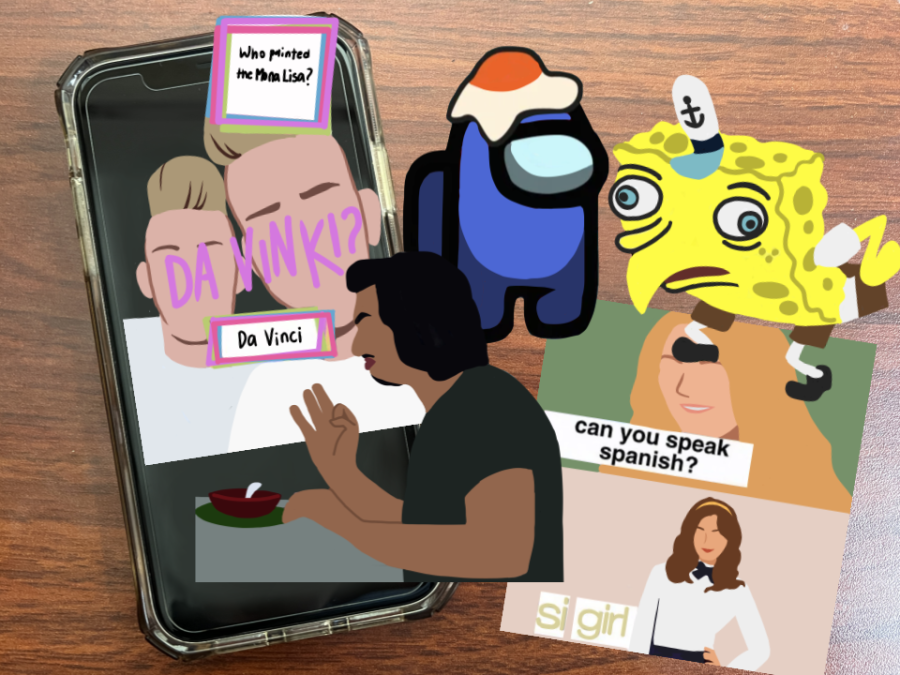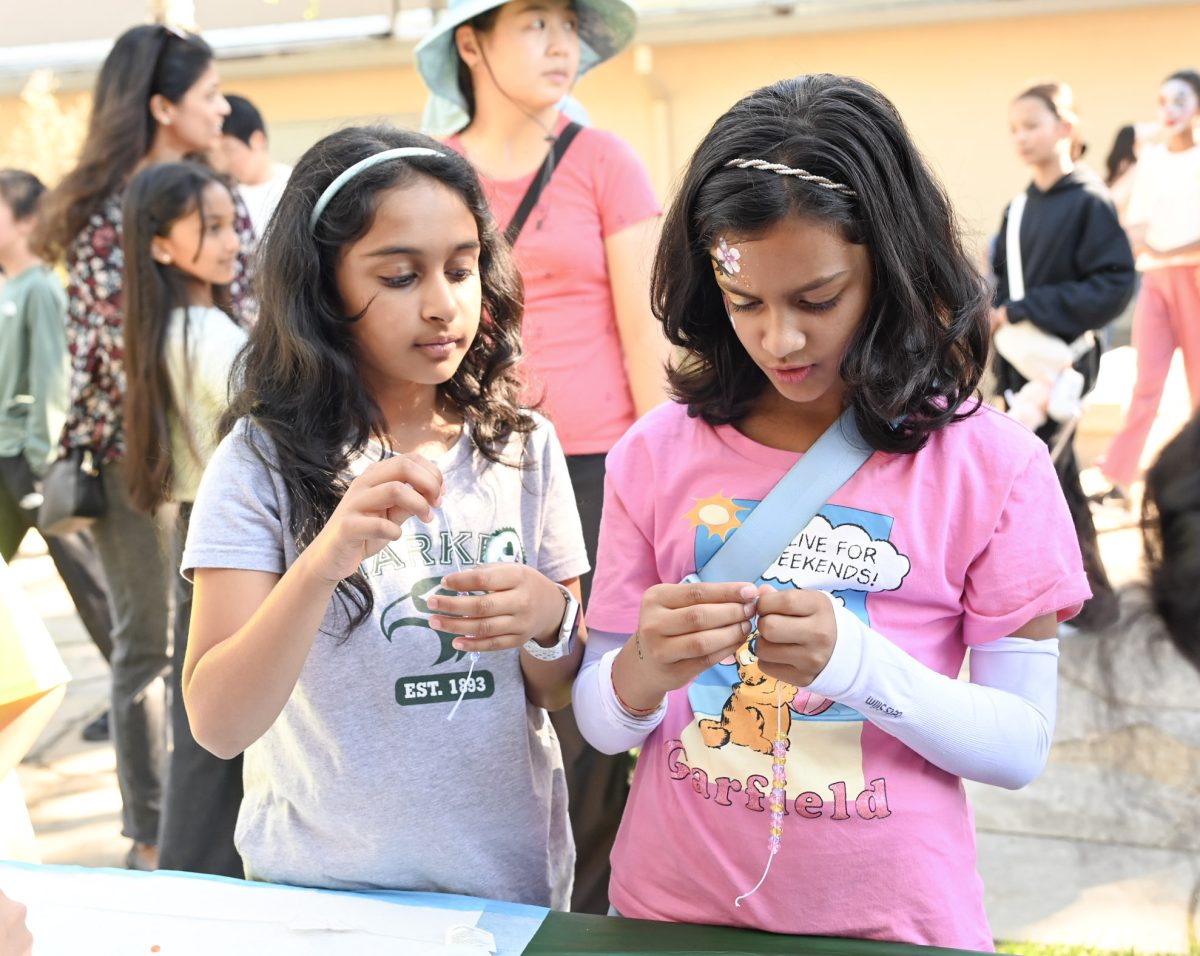‘One big inside joke’: Generation Z uses humor to bond over shared adversity
An illustration of various memes and internet sensations. Social media platforms have guided the evolution of Generation Z’s sense of humor by creating widespread access to topics people find humorous.
February 23, 2022
If you’ve spent time browsing the Internet, you’ve likely encountered videos so absurd that they evoke a chuckle. From a clip of Adam Driver slurping from a spoon and proclaiming “Good soup” with gusto to melodramatic soap-opera-like episodes portrayed by tiny animal dolls, users — especially Generation Z, defined as individuals born from 1997 onward, who often propel the popularity of trending jokes — relish the comedy of the arbitrary. These seemingly random sensations have taken the Internet by storm, becoming universally-known bits spreading across social media platforms such as TikTok, Twitter, Instagram and now defunct Vine and making their way into day-to-day conversations.
These social media platforms have guided the evolution of Generation Z’s sense of humor by creating widespread access to topics people find humorous. Economics and history teacher Matthew McCorkle views faster cycles of trending jokes and creation of new comedy as a result of the ability for media to spread quickly.
“When it comes to a joke, people imitate the joke,” McCorkle said. “Eventually, the joke is a little over done, and then you move on to the next one. The cycle of humor is much faster, and the drive to innovate is also faster, which I think is a good thing…[In the era before social media,] you could get away with reusing jokes and joke formats because everyone hadn’t already seen it.”
As a result of universal access to trending jokes, interactions often involve referential humor, where a statement such as quoting a video has comedic effect because it references a format or a meme deemed funny despite not having an evident punchline when referenced in speech on its own. James Blenko (10) appreciates how referential humor plays a large role in creating common cultural knowledge within a generation.
“There [are] these widespread ‘inside jokes’ like quoting Vines, where [they] don’t really mean anything but people around you will laugh because they understand them,” James said. “When you quote a TikTok or a Vine or even say ‘Spider-Man pointing meme,’ it’s very funny, and it signifies the connection of a generation that grew up with this kind of stuff.”
With jokes becoming increasingly universal, they’ve become points of relatability in conversations. James values how these “inside jokes” and comedy as a whole have facilitated building relationships.
“A really easy way to meet people and make them like you is learning how to get them to laugh,” James said. “For a lot of people who struggle more with social interaction like myself, humor was always the first thing you’d go to because it was reliable.”
While familiar topics in general offer a sense of comfort, finding patterns that reference a certain piece of content in unexpected places have hilarity, even without an apparent punchline.
“There’s always an element of recognizing patterns that is inherently humorous or entertaining to us,” Vice president of Philosophy Club Vincent Zhang (11) said. “We derive some kind of pleasure from noticing things that we’ve seen before. There’s a sensation that there’s this inside joke, but it’s not really a joke because millions of people know about it.”
Vincent attributes the appeal of pattern-seeking to the highly saturated content made available through the Internet. In this environment, recognizing patterns and turning them into jokes allows users to cope with the “unknowability” of the media-saturated vastness of content.
“In creating the internet and trying to map out Internet information, we created a world that’s bigger than the map itself, so there’s more information on the Internet than there is in the real world,” Vincent said. “It’s really difficult to live in a society that’s so saturated with things that we don’t understand, so we try to assign a category or something that helps us understand or find humor in it.”
Vicent noticed this habit in a recent TikTok trend centered around “Can’t Help Myself,” an art installation by Sun Yuan and Peng Yu in the Guggenheim Museum of a robot attempting to clean a pool of blood-like red liquid but instead making a larger mess as it continues, representing an “absurd, Sisyphean view of contemporary issues surrounding migration and sovereignty.” Users began to share videos of dramatized mundane activities that mirror the installation’s image, such as one where a man maneuvers a sand scooping toy at a park to emotional music.
“People see that image in everyday life, and then they post it and [they’re] like ‘Haha, it looks just like the original work,’” Vincent said. “The humor has nothing to do with what the original work means: it’s repeating a pattern and being able to recognize it.”
YouTube content creator Olivia Sun notes that another way Gen Z pulls humor from beyond the original content itself is meta irony, a specific type of irony where the punchline derives from contextual clues.
“What puts Gen Z apart from millennials is their use of meta irony. What that means is you have to know the person who says the joke or the source of where the joke came from in order to actually understand the humor of what’s going on,” Olivia said.
In a video analyzing the unique humor of today’s youth, Olivia mentions TikTok user @2006_wii_remote, who cracks jokes dripping with lingo from the 2000s and early 2010s such as “rawr XD potato.” His videos would not be considered funny by Gen Z users if he were a millennial genuinely referencing this dated humor, and viewers perceive his content positively because they poke fun at the past. The ambiguity of whether or not he finds the jokes themselves funny adds to the comedic effect of his online persona.
Although meta irony seems like a new innovation in mainstream universal humor because of its quick rise on social media in the past few years, McCorkle sees similarities between this form of irony and British sketch humor such as the specials by surreal comedy troupe Monty Python. Their sketches subvert classic moralistic stories by portraying them in an absurdly lighthearted yet overly dramatic and serious way.
“I wonder if part of the influence that is now dominating can be traced to [British sketch humor] because it definitely influenced my generation and felt novel at the time as we were discovering this this type of humor, whereas now it appears to be more dominant,” McCorkle said.
Gen Z’s affinity for sarcasm also manifests itself in dark humor or black comedy, which Wikipedia defines as “a style of comedy that makes light of subject matter that is generally considered taboo, particularly subjects that are normally considered serious or painful to discuss.” McCorkle remarks that using humor as a coping mechanism in bleak or tragic circumstances has been a generational constant despite the specific subjects shifting depending on current events.
“Exposure to large issues that may be negative — awareness of climate change, for example — there’s a wry sense that exists there,” McCorkle said. “I don’t really see it as being markedly different from a couple decades ago, just the issues have slightly shifted. Humor has always been a coping mechanism.”
Online jokes about taboo topics like worsening climate change and gun violence have become trending in response to tragic events. James finds that humor, when executed correctly, has become a valuable way to deal with frequent exposure to bleak news topics without taking away from their gravity.
“So many awful things happen now. It’s not that more bad things are happening; it’s that things can spread more easily through news and media,” James said. “You’re not taking how serious [a topic] is out of it by laughing about it. It’s like ‘who are you getting offended on behalf of because I don’t say these things out of hate’ or ‘I don’t joke out of hate, [and] I’m not brushing it off.’ It brings awareness and it helps people cope.”
Olivia notes that dark humor can be a double-edged sword. While it can cultivate passivity toward societal problems or offend people, this humor can also draw attention to these important topics by pointing out their absurdity.
“Sometimes, joking about [a serious topic] too much might make us feel like we don’t really have to do anything…There are limits to humor, but it’s a bigger discussion that people need to have about where to draw that line,” Olivia said. “Humor can be powerful in making a situation more serious or taken seriously by people.”
Most importantly, at a personal level to users, Olivia hopes that joking about one’s own troubles, especially mental health concerns, which have become more prevalent among Gen Z, helps people find communities and alleviate their pain.
“A lot of people make jokes about their mental health and family problems online, but I know that deep down, it probably has done serious harm to them,” Olivia said. “I hope that the humor that people put out will eventually end up being some sort of way for them to seriously connect with other people and form important communities.”


















![“[Building nerf blasters] became this outlet of creativity for me that hasn't been matched by anything else. The process [of] making a build complete to your desire is such a painstakingly difficult process, but I've had to learn from [the skills needed from] soldering to proper painting. There's so many different options for everything, if you think about it, it exists. The best part is [that] if it doesn't exist, you can build it yourself," Ishaan Parate said.](https://harkeraquila.com/wp-content/uploads/2022/08/DSC_8149-900x604.jpg)




![“When I came into high school, I was ready to be a follower. But DECA was a game changer for me. It helped me overcome my fear of public speaking, and it's played such a major role in who I've become today. To be able to successfully lead a chapter of 150 students, an officer team and be one of the upperclassmen I once really admired is something I'm [really] proud of,” Anvitha Tummala ('21) said.](https://harkeraquila.com/wp-content/uploads/2021/07/Screen-Shot-2021-07-25-at-9.50.05-AM-900x594.png)







![“I think getting up in the morning and having a sense of purpose [is exciting]. I think without a certain amount of drive, life is kind of obsolete and mundane, and I think having that every single day is what makes each day unique and kind of makes life exciting,” Neymika Jain (12) said.](https://harkeraquila.com/wp-content/uploads/2017/06/Screen-Shot-2017-06-03-at-4.54.16-PM.png)








![“My slogan is ‘slow feet, don’t eat, and I’m hungry.’ You need to run fast to get where you are–you aren't going to get those championships if you aren't fast,” Angel Cervantes (12) said. “I want to do well in school on my tests and in track and win championships for my team. I live by that, [and] I can do that anywhere: in the classroom or on the field.”](https://harkeraquila.com/wp-content/uploads/2018/06/DSC5146-900x601.jpg)
![“[Volleyball has] taught me how to fall correctly, and another thing it taught is that you don’t have to be the best at something to be good at it. If you just hit the ball in a smart way, then it still scores points and you’re good at it. You could be a background player and still make a much bigger impact on the team than you would think,” Anya Gert (’20) said.](https://harkeraquila.com/wp-content/uploads/2020/06/AnnaGert_JinTuan_HoHPhotoEdited-600x900.jpeg)

![“I'm not nearly there yet, but [my confidence has] definitely been getting better since I was pretty shy and timid coming into Harker my freshman year. I know that there's a lot of people that are really confident in what they do, and I really admire them. Everyone's so driven and that has really pushed me to kind of try to find my own place in high school and be more confident,” Alyssa Huang (’20) said.](https://harkeraquila.com/wp-content/uploads/2020/06/AlyssaHuang_EmilyChen_HoHPhoto-900x749.jpeg)












